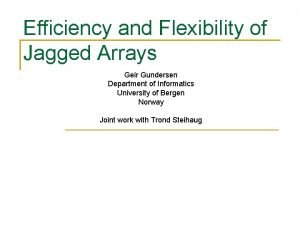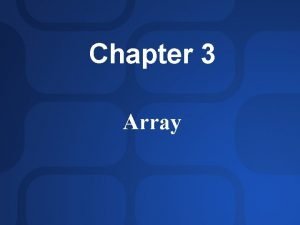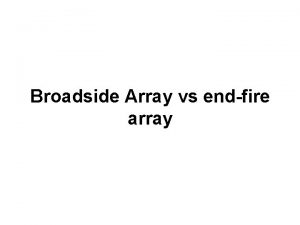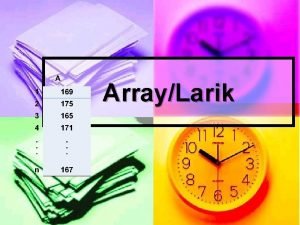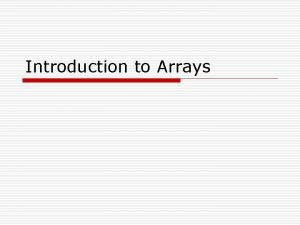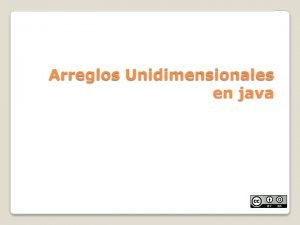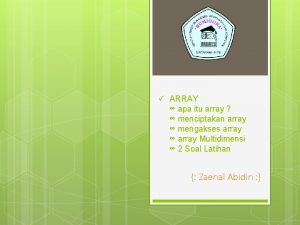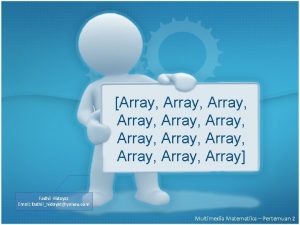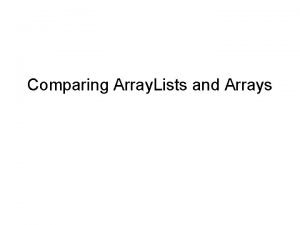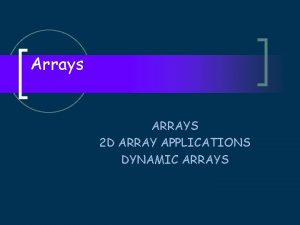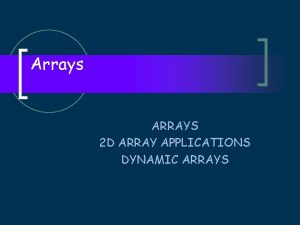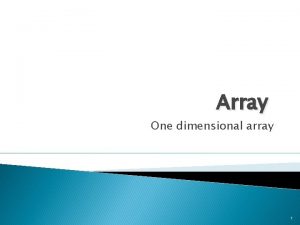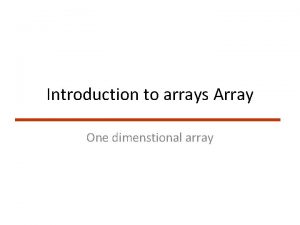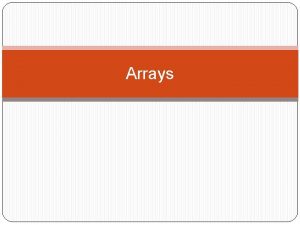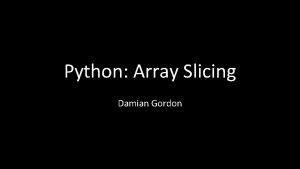Introduction to Arrays Arrays An array is a






![Creating Vectors in MATLAB® >> a = [2. 3 7. 5 4. 3 6] Creating Vectors in MATLAB® >> a = [2. 3 7. 5 4. 3 6]](https://slidetodoc.com/presentation_image_h2/ec158fe03b6f2d85a3970cf5a891b8cf/image-7.jpg)









- Slides: 16

Introduction to Arrays

Arrays § An array is a collection of like elements. § There are many engineering applications that use arrays. § MATLAB® is an acronym for Matrix Laboratory. (A matrix is a two-dimensional array) § MATLAB® stores data in arrays and performs all numerical computations using array operations. Therefore, to use MATLAB® effectively as a computing tool, one must understand arrays and operations with arrays.

1 -d Arrays: Vectors A vector is a one-dimensional array. Examples: A row vector with 4 elements x = [ 0 -1. 5 4 7 ] A column vector with 3 elements y = 5 2. 9 3

2 -d Arrays: Matrices A matrix is a two-dimensional array (like a table). Examples: A= 2. 3 4. 5 -7. 5 3. 2 -5. 1 10 B= 76 92 67 75 95 65 84 82 89 88 70 75 A has 2 rows and 3 columns (2 x 3 Matrix) B has 3 rows and 4 columns (3 x 4 Matrix)

Multi-Dimensional Arrays can have more than two dimensions. For example, a 3648 x 2736 jpg color image imported into MATLAB® would be a 3 -dimensional array of size 3648 x 2736 x 3 where the 3 rd dimension represents the RGB panes as illustrated below. 3 color panes 3648 rows of pixel data 2736 columns of pixel data

Creating 1 -d Arrays (Vectors)
![Creating Vectors in MATLAB a 2 3 7 5 4 3 6 Creating Vectors in MATLAB® >> a = [2. 3 7. 5 4. 3 6]](https://slidetodoc.com/presentation_image_h2/ec158fe03b6f2d85a3970cf5a891b8cf/image-7.jpg)
Creating Vectors in MATLAB® >> a = [2. 3 7. 5 4. 3 6] % Creates a single row of numbers a = 2. 3000 7. 5000 4. 3000 >> b = [2. 3; 7. 5; 4. 3; 6] % Creates a single column of numbers b = 2. 3000 7. 5000 4. 3000 6. 0000

Creating Vectors: Other Options MAXIMUM STARTINCREMENT >> t = -1: 0. 5: 3 t = -1 -0. 5 0 0. 5 1. 0 1. 5 2. 0 2. 5 3. 0 INCREMENT = 0. 5 START MAX. Note: If you leave out the increment (middle value), MATLAB will set increment = 1 >> t = -1: 0. 6: 3 t = -1 -0. 4 0. 2 0. 8 1. 4 2. 0 2. 6

Creating Vectors: Other Options END START Number of Points >> t = linspace(-1, 3, 7) t = -1. 0000 -0. 3333 START 0. 3333 1. 0000 7 Data Points 1. 6667 2. 3333 3. 0000 END

Entry by Entry Math Operators

Example Suppose we create a vector, t, as follows: >> t = 0: 2: 10 t = 0 2 4 6 8 10 What if we wanted to square each entry in the vector, t? >> t^2 Error using ^ Inputs must be a scalar and a square matrix. To compute elementwise POWER, use POWER (. ^) instead.

Arithmetic Operators MATLAB® stores data in arrays and performs all numerical computations using array operations. All of the arithmetic operators: + - * / ^ perform array operations and must follow the rules for arrays. [ 0 2 4 6 8 10 ] * [ 0 2 4 6 8 10 ] (1 x 6) * (1 x 6) Inner Matrix Dimensions are not the same. Invalid Multiplication

Entry by Entry Operators MATLAB® provides entry by entry operators that allow the user to perform computations on each entry in an array. The entry by entry operators are: . * . ^ . /

Back to Example >> t = 0: 2: 10 t = 0 2 4 6 8 How do we square each entry in the vector, t? >> t. ^2 ans = 0 4 16 36 64 100 10

Your Turn … Try these commands (one at a time) in MATLAB. Explain what each command does. >> >> >> x y t z q q a a a = = = = = [5 -3 7 -10] [1; 3; -17] 0: 0. 1: 2 linspace(0, 2, 11) [1 -2 3 9]; q^3 [1 -2 3 9]; q. ^3 [1 2 3]; b = [4 5 6]; a*b [1 2 3]; b = [4 5 6]; a. *b [1 2 3]; b = [4 5 6 7]; a. *b

Test Your Understanding
 Array of arrays c++
Array of arrays c++ Land grid array vs pin grid array
Land grid array vs pin grid array Contoh array
Contoh array Jagged array vs multidimensional array
Jagged array vs multidimensional array Associative array vs indexed array
Associative array vs indexed array Comparison between broadside array and endfire array
Comparison between broadside array and endfire array Array of array in c
Array of array in c Sparse array adalah array yang
Sparse array adalah array yang Pengertian array 1 dimensi
Pengertian array 1 dimensi Photovoltaic array maximum power point tracking array
Photovoltaic array maximum power point tracking array Parallel arrays in c
Parallel arrays in c Parallel arrays
Parallel arrays Veteork
Veteork Parallel arrays
Parallel arrays Why do we need arrays?
Why do we need arrays? Dynamic arrays and amortized analysis
Dynamic arrays and amortized analysis Que es un arreglo unidimensional en java
Que es un arreglo unidimensional en java



